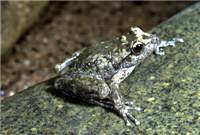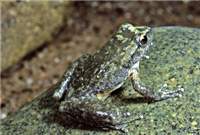Family
HylidaeGenus
LitoriaSpecies
booroolongensisThreats/Control Methods - Regional
Although it is not fully know what has caused the population decline in the Boorloong Frog, three likely factors have been identified; habitat disturbance, chytrid fungus (chytridiomycosis), and predation of both adults and tadpoles by introduced fish such as trout (Salmo trutta) and(Oncorhynchus mykiss), mosquito fish (Gambusia holbrooki), European carp (Cyprinus carpio) and redfin perch (Perca fluviatilis).
Chytrid Fungus is thought to have played a large role in the decline of the species, and other frog species are thought to also be vulnerable to its spread. For this reason care must be taken at all times when entering frog habitats, as the fungus can be spread through mud or water. To prevent the spread of the Chytrid fungus it is important to wash your shoes before entering and after leaving frog habitats. For more information on the Chytrid fungus © Link to fact sheet http://www.deh.gov.au/biodiversity/invasive/publications/c-disease/
Local/Urban Actions
As the species has not been detected in the Tablelands for a period of years any redetection of the species is of value. General monitoring of frog populations in the ACT is done yearly through the Frogwatch Program.The Frogwatch program provides training for community volunteers each October, with monitoring then being undertaken by volunteers over a two week period.For more information on Frogwatch contact: The ACT Frogwatch Coordinator, Ginninderra Catchment Group; Ph(02)62783309 or email: [email protected]. It is also possible to promote urban backyards to frogs as suitable habitat, through simple landscaping techniques. The Australian National University and the Ginninderra Catchment Group have developed a guideline to help you encourage frogs into your backyard called [Link - Creating a Frog Friendly Habitat in the ACT Community]
Distinguishing Features
A small frog with mottled grey, black, brown markings. Its shape slightly resembles that of a toad, as it is rotund nature. The belly is a creamy white colour. In size the species range from 30-58mm. In appearance the Booroolong Frog is very similar to the Rocky Stream Frog (Litoria lesueuri), distinguished by the absence of the black stripe running from behind the eye through to below the arm, but present on the Rocky Stream Frog.As calls are the most likely way of being notified that a frog is residing nearby it is not surprising to find that call identification is by far the easiest way to recognise the species. The call of the Booroolong frog has been described as a soft repeated purring ©quirk-quirk-quirk©. The call sounds very similar to the Rocky Stream Frog and is hard to identify without experience.
Common name/s
Booroolong Frog
Similar Species
The Green and Golden Bell Frog (Litoria auera), the Tablelands Bell Frog (Litoria castenea), the Broad-palmed Frog ( Litoria latopalmata), the Rocky Stream Frog (Litoria lesueuri), the Southern Leaf-Green Tree Frog (Litoria nudidigitus), Peron©s Tree Frog (Litoria peronii), the Southern Bell Frog (Litoria raniformis), the Spotted Tree Frog (Litoria spenceri) and the Whistling Tree Frog ( Litoria verreauxii verreauxii).
Distribution
Tablelands and slopes of NSW.
Country of Origin
Australia
Survey Techniques
Call identification is by far the easiest and simplest way to detect frogs.
Conservation (Pet/Pest) Status - National
The species status is listed as of concern Wildlife Australia©s The Action plan for Australian Frogs. The species is currently under assessment for listing as Endangered under the Environment Protection and Biodiversity Act 1999 (EPBC act).
Conservation (Pet/Pest) Status - Regional
Within NSW the species is listed as endangered under the Threatened Species Conservation Act 1995. Listed as Threatened under the Victorian Flora and Fauna Guarantee Act 1998.
LSCCES Population
Historically the species has been known to have been common in parts of the Northern and Central Tablelands of NSW, although not within the ACT. Currently it has not been detected within the Northern Tablelands for the last 15 years and is thought to have become locally extinct from these areas.
Associated Vegetation Community
Streamline vegetation including ferns such as [Blechnum spp] and [Gleichenia spp] , grasses such as [Poa spp]and sedges such as[Carex] and [Cyperus] spp are valuable as they provide shelter for the frogs and debris to hide under.
[Dry sclerophyll forests], [Forested wetlands],[ Grassy woodlands].Limiting Resources
Previously occurred above 800m, near rocky streams, both ephemeral and permanent.
Breeding
Breeds from November through to January.
Behaviour
During the breeding season males call from the edges of banks or floating vegetation. Females lay their eggs under rocks in bodies of still or moving water.
Functional Group
Insectivore
Food Species
Small invertebrates.
Predators
The native Black Snake (Pseudechis porphyriacus) has been known to consume the occasional Booroolong Frog, as have introduced fish including trout (Salmo trutta) & [Oncorhynchus mykiss], mosquito fish (Gambusia holbrooki), European carp (Cyprinus carpio) and redfin perch (Perca fluviatilis).
Interesting Fact
A study by Smith and Hunter (2005) suggests that male Booroolong frogs may alter their mating calls with respect to which other individuals are calling at the time, in order to make their call the more attractive to females!
References - (reader suitability of references, P=Primary teachers, S=Secondary students, T=Tertiary students and researchers)
Journals:
Shine, R. (1977). Habits, diets, and sympatry in snakes: a study from Australia. Can. J. Zool.55: 1118-1128. T
Smith, M. & Hunter, D.(2005). Temporal and Geographic Variation in the Advertisement Call of the Booroolong Frog (Litoira booroolongensis: Anura: Hylidae). Ethology 111: 1103-1115. T
Online Publications:
Bann, G. It's not easy being green - The plight of Hunter Valley frogs. Accessed 1 July 2006.Available online: www.greeningaustralia.org.au/GA/NAT/TipsAndTools/exchange/Publications+Library/Fact+Sheets+and+Case+Studies/The+plight+of+Hunter+Valley+frogs.htm
S, T
Department of Environment and Conservation. Booroolong Frog - Murrumbidgee: Distribution and vegetation associations in the Murrumbidgee. Accessed 1 July 2006. Available online: http://threatenedspecies.environment.nsw.gov.au/tsprofile/profile_data.aspx?id=10484&cma=Murrumbidgee S, T
Department of Environment and Conservation NSW. Booroolong Frog © profile. Accessed 1 July 2006. Available online:http://threatenedspecies.environment.nsw.gov.au/tsprofile/profile.aspx?id=10484 S, T
EPBC. Nomination litoria booroolongensis, Booroolong Frog. Accessed19 March 2006. Available online: http://www.deh.gov.au/biodiversity/threatened/nominations/pubs/booroolong-frog.pdf S, T
NSW Parks and Wildlife service. Booroolong Frog - endangered species listing: NSW Scientific Committee - final determination. Accessed1July 2006. Available online:
http://www.nationalparks.nsw.gov.au/npws.nsf/Content/Booroolong+Frog+-+endangered+species+listing
S, T
Researcher: Pippa Jaminon


 Top
Top Top
Top